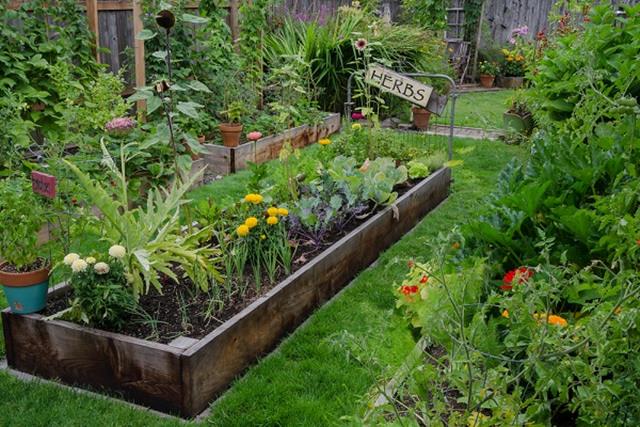Raised bed vegetable gardening is a popular and effective method for growing plants in the UK. By creating raised beds, gardeners can improve soil quality, drainage, and overall crop yield.
In this article, we will explore the benefits of raised bed vegetable gardening in the UK, how to select the right location for your raised bed garden, choosing suitable vegetables for the climate, building and setting up your garden, maintenance tips, pest and disease management, as well as harvesting your bountiful yield. Whether you are a beginner or experienced gardener in the UK, this guide will provide valuable insights into successfully cultivating vegetables in raised beds.
One of the key advantages of raised bed vegetable gardening in the UK is the ability to control and enhance soil quality and drainage. The elevated nature of raised beds allows for better aeration and drainage compared to traditional ground-level gardening. This is especially beneficial in areas with heavy clay soils or poor drainage conditions common in many parts of the UK. By creating optimal growing conditions through raised beds, you can expect healthier plants and higher yields.
When it comes to selecting a location for your raised bed garden in the UK, factors such as sunlight exposure and accessibility are crucial considerations. Most vegetables thrive in full sun, so choosing a spot that receives at least 6-8 hours of sunlight per day is ideal.
Additionally, ensuring easy access to your raised beds will make maintenance tasks such as watering, weeding, and harvesting more convenient. By strategically placing your raised bed garden in a sunny and accessible area, you can set yourself up for success in growing an abundance of fresh produce right at home.
Benefits of Raised Bed Vegetable Gardening in the UK
Raised Bed Vegetable Gardening in the UK offers numerous benefits, with improved soil quality and drainage being two key advantages. By opting for raised beds, gardeners can have more control over the composition and structure of their soil, leading to healthier plants and higher yields. In the UK, where heavy clay soils are common, raised beds offer the perfect solution for creating optimal growing conditions for vegetables.
Improved Soil Quality
One of the main benefits of raised bed vegetable gardening in the UK is the opportunity to fill the beds with high-quality soil. This allows gardeners to create a customized growing environment that meets the specific needs of their crops.
Incorporating organic matter such as compost and well-rotted manure can improve soil fertility and provide essential nutrients for plant growth. Additionally, raised beds provide better aeration compared to traditional ground-level planting, promoting root development and overall plant health.
Enhanced Drainage
Another advantage of raised bed gardening in the UK is improved drainage. In regions where excessive rainfall can lead to waterlogged soil and root rot, raised beds offer a solution by allowing excess water to drain more efficiently.
By elevating the planting area, water is less likely to accumulate around plant roots, reducing the risk of water-related diseases and promoting healthy growth. Proper drainage is essential for successful vegetable cultivation in the UK climate, making raised beds a popular choice among gardeners looking to overcome soggy soil challenges.
Selecting the Right Location for Your Raised Bed Garden in the UK
When considering where to place your raised bed vegetable garden in the UK, it is essential to take into account two crucial factors: sunlight and accessibility. Sunlight is a vital component for the successful growth of vegetables, as most crops need at least six hours of direct sunlight daily.
When selecting a location for your raised beds, choose an area that receives adequate sunlight throughout the day, especially during the growing season. This will ensure that your plants thrive and produce a bountiful yield.
In addition to sunlight, accessibility is another important factor to consider when deciding on the location for your raised bed garden in the UK. Make sure that the site you choose is easily accessible for watering, weeding, and harvesting.
Avoid placing your raised beds too far from a water source or in an area that is difficult to reach, as this can make maintenance tasks more challenging. By selecting a convenient location for your raised bed garden, you will be able to enjoy gardening without unnecessary hassle.
Furthermore, take note of any obstructions that could potentially block sunlight or hinder access to your raised beds. Avoid placing your garden near tall trees or structures that could shade your plants and limit their growth.
Additionally, ensure that there are no obstacles blocking pathways to your raised beds, making it easy for you to tend to your crops whenever necessary. Carefully choosing the right location for your raised bed vegetable garden in the UK will set the foundation for a successful and enjoyable gardening experience.
Choosing the Best Vegetables for Raised Bed Gardening in the UK
When it comes to choosing the best vegetables for raised bed gardening in the UK, it is essential to consider the unique climate conditions of the region. The temperate maritime climate of the UK means that certain crops thrive more easily than others. By selecting vegetables that are well-suited to the UK’s climate, you can increase your chances of a successful harvest.
Root Vegetables
Root vegetables such as carrots, radishes, and beets are great choices for raised bed gardening in the UK. These crops prefer well-draining soil and plenty of sunlight, which can be easily achieved in a raised bed garden. With proper care and attention, root vegetables can produce a bountiful harvest while also improving soil quality over time.
Leafy Greens
Leafy greens like lettuce, spinach, and kale are excellent options for raised bed vegetable gardening in the UK. These crops grow well in cooler temperatures and can thrive in raised beds with good drainage. Planting leafy greens in early spring or late summer can help avoid bolting due to high temperatures, ensuring a steady supply of fresh produce throughout the growing season.
Herbs
Herbs such as basil, parsley, and chives are perfect additions to a raised bed garden in the UK. These flavorful plants are relatively low-maintenance and can be grown alongside other vegetables. With their ability to withstand varying weather conditions, herbs can provide a continuous source of culinary inspiration for home cooks looking to enhance their dishes with fresh flavors from their garden.
Building and Setting Up Your Raised Bed Garden
Raised bed vegetable gardening in the UK is a popular choice for many gardeners due to its numerous benefits. When it comes to building and setting up your raised bed garden, there are several key considerations to keep in mind to ensure its success. From selecting the right materials to determining the size and design of your raised beds, each step plays a crucial role in creating a thriving vegetable garden.
When choosing materials for your raised bed garden in the UK, opt for durable options that can withstand the changing weather conditions. Some common choices include treated lumber, cedar wood, or even recycled plastic lumber. These materials are not only sturdy but also resistant to rot, ensuring the longevity of your raised beds. Additionally, consider using galvanized steel or aluminum corners for added stability and support.
In terms of size and design, it’s important to plan out the layout of your raised bed garden carefully. Consider factors such as accessibility, spacing between beds, and ease of maintenance when deciding on the dimensions.
A popular choice is to create beds that are no wider than 4 feet, as this allows you to easily reach into the center from either side for planting and harvesting. You can also customize the height of your raised beds based on your preference and physical capabilities.
To further enhance the design of your raised bed vegetable garden in the UK, consider incorporating trellises or hoops for climbing plants like peas or tomatoes. This not only maximizes space but also adds a decorative element to your garden.
Additionally, adding mulch around your raised beds can help retain moisture in the soil and suppress weeds. By carefully selecting materials, determining the size and layout of your beds, as well as adding unique design elements, you can create a visually appealing and productive raised bed vegetable garden in the UK.
- Choose durable materials such as treated lumber or cedar wood
- Consider using galvanized steel or aluminum corners for added stability
- Create beds that are no wider than 4 feet for easy access
- Customize the height of your raised beds based on preference
- Incorporate trellises or hoops for climbing plants
- Add mulch around beds to retain moisture and suppress weeds
Maintaining Your Raised Bed Garden in the UK
Maintaining a raised bed vegetable garden in the UK is crucial to ensure healthy plant growth and a bountiful harvest. Proper care involves regular watering, timely weeding, and appropriate fertilizing. Here are some essential tips to help you maintain your raised bed garden effectively:
- Watering: One of the key factors in maintaining a successful raised bed vegetable garden is providing adequate water to your plants. In the UK, where rainfall can be inconsistent, it’s important to monitor soil moisture levels regularly. Water deeply but infrequently to encourage deep root growth. Consider installing a drip irrigation system or soaker hoses for efficient watering.
- Weeding: Weeds can quickly take over your raised bed garden and compete with your vegetables for nutrients and sunlight. Regular weeding is essential to keep them at bay. Pull out weeds by hand or use mulch to suppress their growth. Be sure to remove weeds when they are still small to prevent them from spreading.
- Fertilizing: To ensure that your vegetables have the necessary nutrients for healthy growth, consider adding organic fertilizers to your raised bed garden. Compost, well-rotted manure, or organic granular fertilizers can be applied before planting or as a top dressing during the growing season. Avoid using chemical fertilizers that can harm beneficial microorganisms in the soil.
By following these watering, weeding, and fertilizing tips, you can maintain a thriving raised bed vegetable garden in the UK throughout the growing season. Remember that regular monitoring and adjustments based on plant needs are key to successful maintenance of your garden. With proper care and attention, you’ll be rewarded with a plentiful harvest of fresh, homegrown produce for your table.
Dealing With Pests and Diseases in Raised Bed Vegetable Gardening in the UK
Pests and diseases are common challenges that gardeners face when cultivating plants, especially in raised bed vegetable gardening in the UK. However, there are practical solutions that can help mitigate these issues and ensure a successful harvest. One effective method is practicing crop rotation, which involves changing the location of crops each season to prevent pests and diseases from building up in the soil. This technique helps break the lifecycle of harmful organisms and promotes plant health.
Additionally, using physical barriers such as row covers or netting can protect your plants from pests like birds, insects, and small mammals. These barriers act as a shield, preventing unwanted visitors from damaging your crops without the need for chemical pesticides. You can also companion plant by growing certain herbs or flowers alongside your vegetables to naturally deter pests. For example, planting marigolds near your tomatoes can ward off nematodes and whiteflies.
When it comes to diseases in raised bed vegetable gardening in the UK, proper sanitation practices are crucial. Make sure to clean your gardening tools regularly to prevent the spread of pathogens between plants. It’s also essential to remove any infected plant debris promptly and avoid working in wet conditions that promote disease development. By following these practical solutions for dealing with pests and diseases, you can maintain a healthy and thriving garden all season long.
| Technique | Benefit |
|---|---|
| Crop Rotation | Prevents build-up of pests and diseases in the soil |
| Physical Barriers | Protects plants from birds, insects, and small mammals |
| Companion Planting | Naturally deters pests by planting compatible flora together |
Harvesting and Enjoying the Fruits of Your Labor
As you wrap up your raised bed vegetable gardening journey in the UK, it’s essential to focus on reaping the rewards of your hard work. Harvesting your homegrown vegetables is a fulfilling experience that truly embodies the farm-to-table concept. By following some tips for a bountiful yield in your UK vegetable garden, you can enjoy fresh and nutritious produce right from your own backyard.
One key aspect to ensure a successful harvest is timing. Different vegetables have varying maturity periods, so it’s crucial to track when each crop is ready for picking.
For example, leafy greens like lettuce and spinach are best harvested continuously as they reach maturity, whereas root vegetables such as carrots and beets should be harvested when they have reached their peak size. By understanding each vegetable’s ideal harvesting time, you can maximize the yield of your raised bed garden.
Another important factor for a bountiful harvest is proper care and maintenance of your raised bed garden. Regular watering, weeding, and fertilizing are essential to support healthy plant growth and development. Additionally, keeping an eye out for any signs of pests or diseases can help prevent any potential damage to your crops.
By staying proactive in maintaining your garden, you can ensure that your plants thrive and produce a plentiful harvest throughout the growing season. With these tips in mind, you can savor the satisfaction of enjoying fresh and flavorful homegrown vegetables straight from your raised bed vegetable gardening endeavor in the UK.
Frequently Asked Questions
What Vegetables Should Not Be Grown in a Raised Bed?
Certain root vegetables, like carrots and parsnips, should not be grown in raised beds due to their need for deep soil to develop properly. These vegetables may end up stunted if grown in a shallow raised bed.
What Do You Put in the Bottom of a Raised Vegetable Bed?
To improve drainage and prevent soil compaction in a raised vegetable bed, placing a layer of gravel or rocks at the bottom can be beneficial. This allows excess water to drain away, avoiding waterlogging the soil.
How Deep Should a Raised Garden Bed Be for Vegetables?
The recommended depth for a raised garden bed for vegetables is typically around 12 inches at minimum. However, some crops with deeper root systems may require deeper beds, ranging from 18 to 24 inches. It’s important to consider the specific needs of the vegetables you plan to grow when determining the depth of your raised bed.

If you’re looking to get into vegetable gardening, or are just looking for some tips on how to make your current garden better, then you’ve come to the right place! My name is Ethel and I have been gardening for years. In this blog, I’m going to share with you some of my best tips on how to create a successful vegetable garden.





